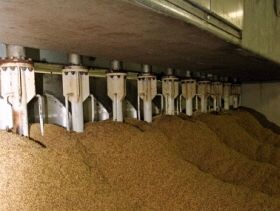 K feed wheat futures were more than £2 per tonne higher than the Friday figures nearly reaching £170 per tonne according to figures from the UK’s Home Grown Cereals Authority, part of the Agricultural and Horticultural Development Board.
K feed wheat futures were more than £2 per tonne higher than the Friday figures nearly reaching £170 per tonne according to figures from the UK’s Home Grown Cereals Authority, part of the Agricultural and Horticultural Development Board.New crop 14 November London wheat was up by £3.50 a tonne to £158.55 a tonne.
In Paris on Monday wheat closed €4.25 a tonne higher at €214.00 a tonne, and 14 June Paris corn was up by €2.00 a tonne at €189.00 a tonne.
US wheat futures also went higher in early trade with EU grains on Monday following the EU trends and staying there.
However, while markets outside Ukraine are nervous, there is little sign of disruption in Ukraine itself or the region as a whole.
The HGCA said that on Friday, 12 April, Egypt bought 55,000 tonnes of wheat from Ukraine as well as 50,000 tonnes from Russia and 120,000 tonnes from Romania, “reflecting, to an extent, the country's confidence in obtaining Ukrainian wheat”.
And this week Ukraine published export figures that showed an increase on last year.
Actual exports up by 28,479,000 tonnes, of which: wheat is up by 7,991,000 tonnes, corn by 18,053,000 tonnes, barley by 2,154,000 tonnes and other grains by 281,000 tonnes.
However, the Agriculture Ministry said that there was also 1,139,000 tonnes of cereals (wheat – 392,000 tonnes, barley – 106,000 tonnes, corn – 631,000 tonnes) in elevators in the ports and another 135,000 tonnes loaded on ships.
This makes the total volume exported and ready up by 29.8 million tonnes (wheat - 8.4 million tonnes, barley - 2.3 million tonnes and maize - 18.7 million tonnes).
The troubles in the region also do not appear to have affected the confidence in the farming community in Ukraine to continue sowing this spring.
The official data shows that about 92 per cent of the grain and pea crops had been sown with some regions - Nikolayev, Odessa, Kherson, Vinnytsia, Volyn and Chernihiv and Transcarpathian - having completed sowing.
In all 18.3 million hectares are expected to be sown with spring crops.
The picture is also looking good for the winter rape crop with most of the area sown considered to be satisfactory or in good condition.
However, there are concerns over the winter wheat because of the arrival of some dry weather, which experts fear could affect the crops later in the year.
In Russia itself, the outlook is bullish.
At a recent Asian economic forum in Boao, VChina, the Deputy Prime Minister, Arkardy Dvorkovich forecast that Russia’s grain production would exceed 120 million tonnes in the next six years, giving the country an export opportunity of 40 million tonnes.
And on the markets Russia has started selling grain from intervention under repurchase agreements. Between October and February the state bought in 610,000 tonnes at a cost of 3.57 billion rubles and it has just released 62,000 tonnes at 438 million rubles.
The Russian Grain Union estimates that this year Russia will export 25 million tonnes of grain.
However, while there is an optimistic mood in agriculture in the Black Sea area, Crimea is the one area that appears to have suffered.
Where Crimea was expected to produce between 1.5 and 2 million tonnes of grain it only produced 1.3 million tonnes, because of crop failure.
And the president of the Russian Grain Union, Arkardy Zlochevsky, has said that there are difficulties in planting in Crimea.
Much of the problem lies in the fact that Crimea used to receive seed, fuel and fertiliser from Ukraine, these supplies have now ceased.
There are also concerns that there could be a water shortage in Crimea because most of the water comes from the Dniper River which also flows through Ukraine and Belarus and the worries are that the flow of the river could be restricted upstream.





